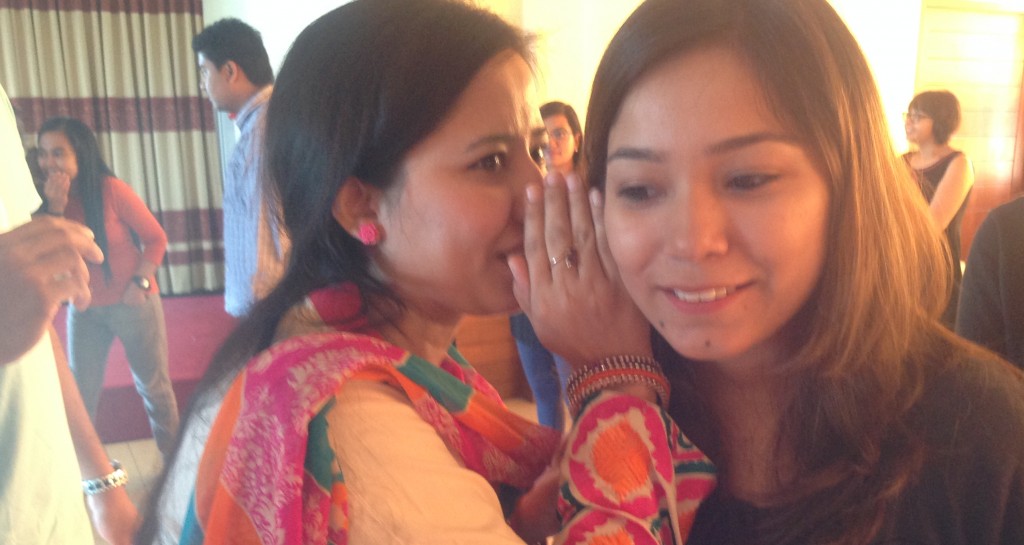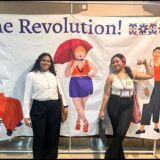Getting Noticed…. Online!!!
SAY WHAT? Chinese whispers and the Communication Loop
Participants played a round of Chinese whispers and quickly realized how easily a message can easily be distorted within a small group of recipients and that what the sender wants to convey is rarely received in its entirety. There was a discussion post this activity, on the different types of messages – internal and external, importance of receiving feedback, various mediums etc.
What is the Internet? Is it virtual? It is a cloud in space?
lthough we use the Internet prolifically, few of us know what it actually is. Nadine Moawad, a feminist activist from the Association of Progressive Communications www.apc.org working on issues related to the Internet and rights, gave participants an overview of the Internet and how it evolved. To illustrate how the Internet is actually something physical and not simply virtual, she gave an example of how in Armenia a goat ate the country’s Internet cable, and it cut off the country’s Internet for 7 hours. She asked participants to analyze how the Internet runs, who owns it or makes decisions about usage and the politics behind it.
What constitutes harmful content online?
Participants were then divided into groups and asked to discuss what they think is harmful Internet content and should be banned. Groups came up with several points including nonconsensual sexual content, portraying sexuality in an obscene manner, child pornography, sexual violence etc. The facilitator asked participants to examine who gets to decide what content is appropriate for others to watch? She gave the example of how controls over Internet content are being exercised under the guise of ‘protecting children’.
“Children are always curious about sex and sexuality and if we put enough content out there on being safe and consent and reproductive health – they’re likely to find it”
The Ideal Internet
Participants then discussed issues related to how the Internet is evolving, including – privatization, monopoly of some companies and net neutrality. They were asked to imagine what sort of Internet they wanted:
“Freedom of speech, two way communication, accessible, affordable, gender sensitive, privacy and confidentiality, safe, fact-based….”
Using Social Media effectively
This session examined how the Internet can be used for social advocacy. Nadine shared how social media transformed journalism because it gave everyone the power to share content and for that information to go viral and reach the masses. In essence everyone became a reporter.
Participants were then divided into groups to discuss social media campaigns that were successful in their own countries and the reasons why. These were some examples that they shared:
India: Kiss of love – Youth protested against moral policing in India by kissing in public / publically displaying affection and posting these photographs. The group chose this example because it brought in other supporters and generated conversations across groups. The facilitator noted how social media could create a viral effect for smaller campaigns that started offline.
Iran: My stealthy freedom – Asked woman and girls to take off their veils in public spaces and to post these on their social media pages. Received over 800,000 likes and defied exiting norms.
Myanmar: Black Ribbon Day – Successive Burmese governments since the military took over in the ’60s had transferred retired military officers into management positions in various civilian departments and army appointees across various sectors had stifled the progress of experienced civilian staff. Heath care professions / medical students protested against the recruitment of soldiers in the public health system by changing their profile pictures using black ribbons. As a result the Minister of health apologized and stopped the process.
Nepal: Breaking the record to unite hearts – People mobilized online to participate in forming the largest flag of Nepal (35,000 people gathered to form the flag).
Philippines: Purple Ribbon campaign – Participants changed their profile picture to include a purple ribbon that symbolized their request for the reproductive health bill to be passed. Offline rallies and campaigns were also conducted to rally for the bill to be passed.
Sri Lanka: ItsHerRight – ASAP Youth posted hundreds of multi-lingual post-cards on behalf of youth around the country to the president – challenging the abortion law in the country.
The group further analyzed what made these campaigns successful and what tactics and strategies they could adopt for their own social media activities. They worked in groups to identify networks comprising groups from their respective countries that could possibly help their cause and promote their work.
FACEBOOK: GETTING NOTICED
“Ask yourself what would others (on your page or your twitter followers) like to share? Who is my audience and what content can I create that they would want to share”?
Nadz concluded the day with a presentation on how to get noticed on Facebook. She discussed the need to have a strategy for one’s page that could include wanting to share information, show support, recruit volunteers and supporters, influence discourse, interact with supporters, showcase activities etc. She emphasized that the more contextual the content, the more success the page has – so explain why the information you’re sharing is relevant at this point. Similarly, it is important to cite sources because it makes your content more authentic and to post original, timely content. She urged participants to vary their content and to analyze how other similar organizations in their regions were faring and set their own benchmarks accordingly.









